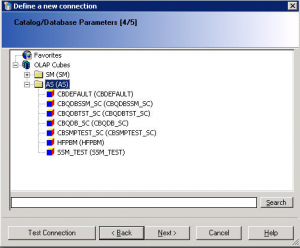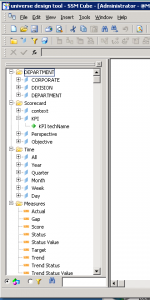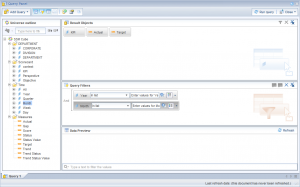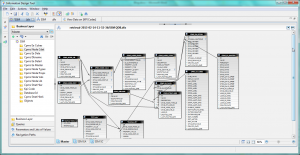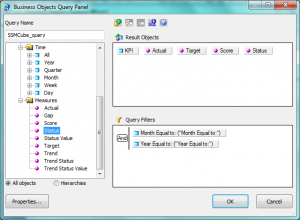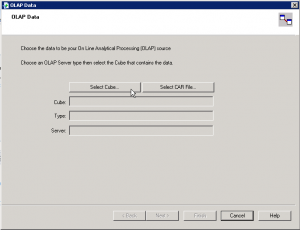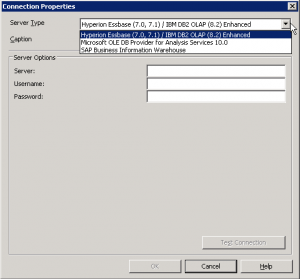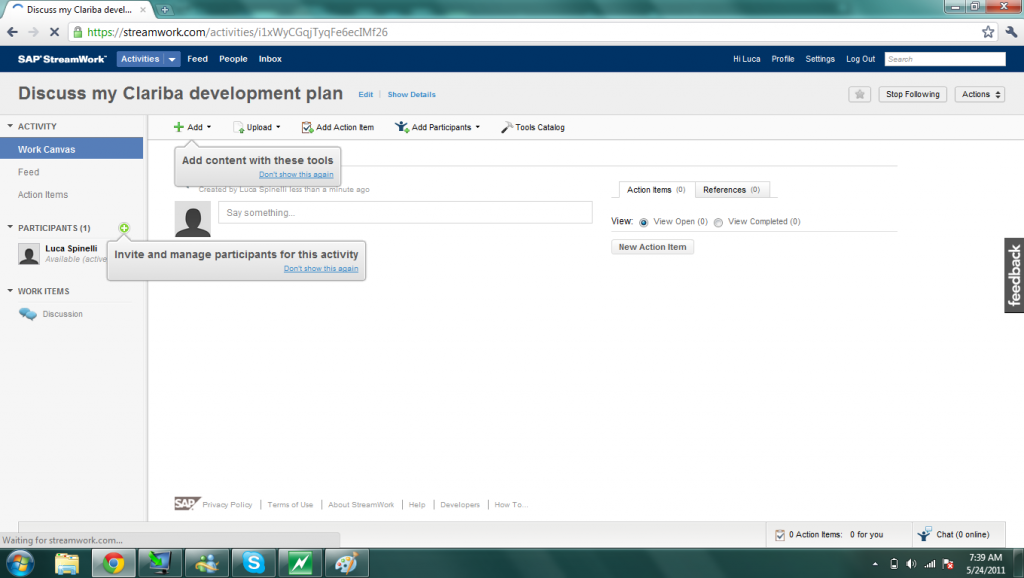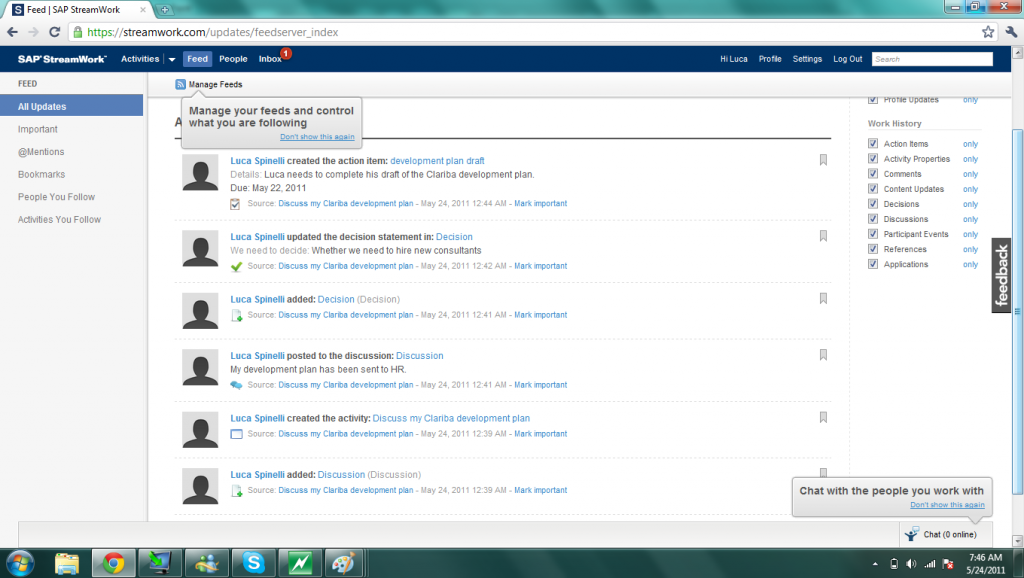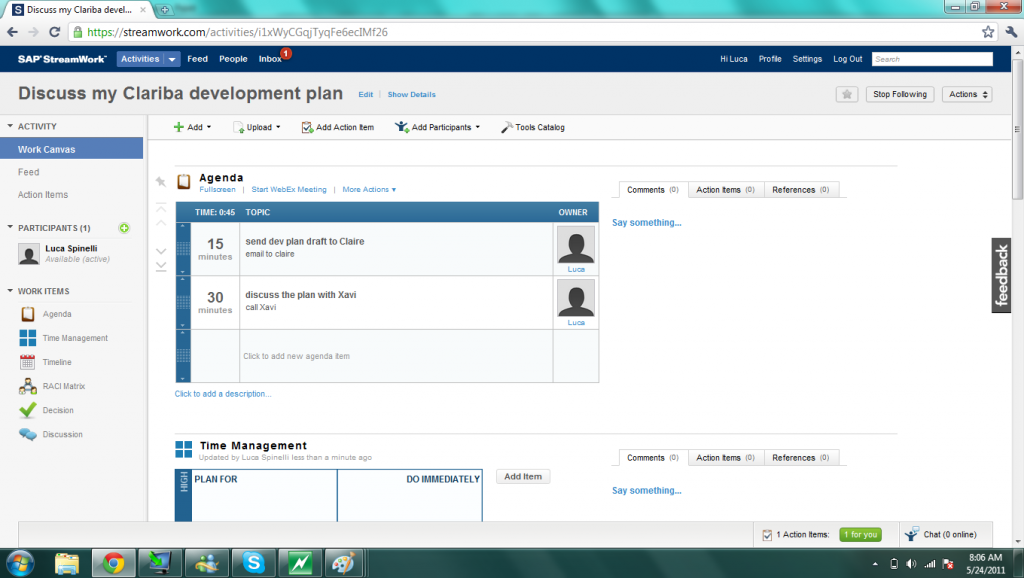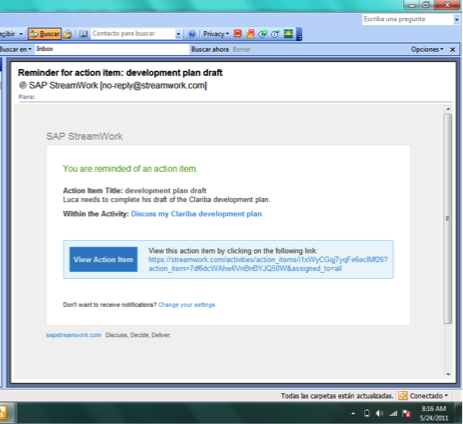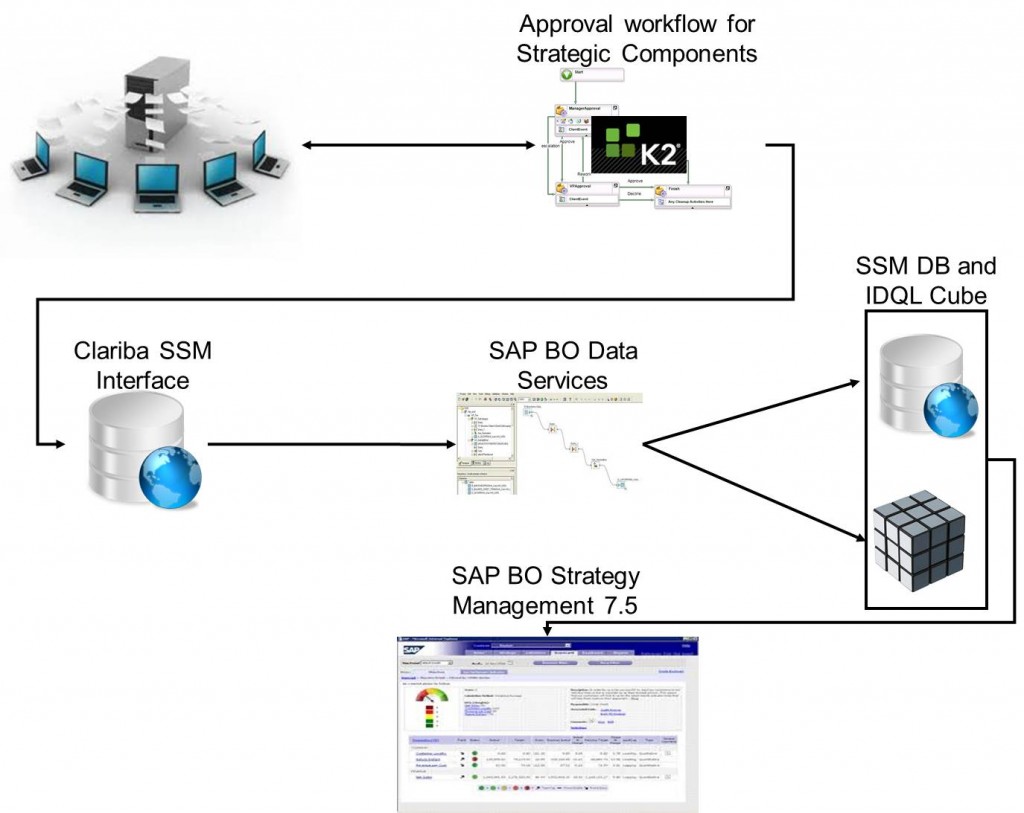Bring your strategy to life with SAP Strategy Management
Getting the most from your SAP Strategy Management 10.0
You have successfully implemented SAP Strategy Management (SSM) in your company and users are gradually becoming familiar with that new tool. What’s next? How do we motivate managers to adopt it and use it as a support to their decision making tasks? In this article I would like to share my thoughts about the following topics
Providing SSM data to SAP BusinessObjects reporting tools - Exhausting all scenarios
In the last two months I have been in a couple of customers who were interested in the integration of SAP Strategy Management 10.0 with SAP BusinessObjects BI Platform 4.0. In this post I would like to explain what that integration is about.
First of all, a brief introduction about the solution. The SAP Strategy Management (SSM) software allows aligning the Strategy Plan of the company and its key objectives and spread it across all the organization. It is an out of the box Enterprise Performance Management solution in which you can insert the most important KPIs of your company in Balanced Scorecards or Strategy Maps and control their performance in relation to the Strategy of the company. Within SSM you can also create initiatives to implement improvements or corrective actions and link them to the objectives or KPIs.
Sometimes the customer has requirements to implement reports or further analysis on top of SSM and these cannot be covered with the standard functionality of the solution. In that case, the best option is to implement the integration between SSM and SAP BusinessObects reporting tools. Some examples of what you can do with that integration:
- Implement bespoke Dashboards with your SSM KPIs and Objectives
- Implement universes and allow users to exploit information from SSM with Web Intelligence without consuming additional SSM licenses
- Implement pixel-perfect Crystal Reports on top of the SSM
- Foster ownership with Publications. For example, send a list of KPI’s that are not performing well to their responsible users
For implementing such integration, you can follow the SAP SSM Configuration guide. However, in some cases, there is lack of documentation and you have to do things outside the script. In other cases, the existing documentation has not been updated yet to BI 4.0 and SSM 10.0. And finally, sometimes the documentation is wrong or the software has bugs and you cannot setup the integration.
In this post we will analyze following scenarios:
- Web Intelligence reporting on top of a SSM Models
- Web Intelligence reporting on top of a SSM Data Model (Clariba-developed solution)
- Crystal Reports on top of SSM (exploring different options)
- Dashboards on top of SSM (exploring different options)
These scenarios have been implemented with following software components:
- SAP NetWeaver 7.3 SP08
- SAP SSM 10.0 SP06
- SAP BusinessObjects BI Platform 4.0 SP05
- Crystal Reports 2011 SP05
- Dashboards 4.0 SP05
1. Web Intelligence reporting on top of a SSM Model
As per SAP documentation, we can setup the ODBO Provider in order to build a Universe on top of SSM Models. The problem is we still have to use the Universe Designer instead of the Information Design Tool of the BI 4.0. Bellow are the steps for setting up the ODBO Provider and implementing your first report on top of the SSM:
- Go to your BO 4.0 server and make sure you have a Multimensional Analysis Service in the BO server. Stop the MDAS Server and the Connection Server in the Central Configuration Manager
- Copy the ODBOProvider folder from the <drive>:Program files (x86)SAP BusinessObjectsStrategy ManagementInternetPub path of your SSM server to the BO server
- In the SSM server, run the SSMProviderReg.bat file in the BO server. Make sure you have administrator rights in the BO server. Once completed, check in the regedit that you are able to find the register SSMProvider.1 in the Windows register
- Modify the windows register to insert following string in that path (assuming that you are using a 64-bit Windows): HKEY_LOCAL_MACHINESOFTWAREWow6432NodeSAPSSMODBOProvider "servletUri"="/strategyServer/ODBOProviderServlet"
- Access the following path in BO server: <drive>:Program Files (x86)SAP BusinessObjectsSAP BusinessObjects Enterprise XI 4.0dataAccessconnectionServeroledb_olap
<DataBase Active="Yes" Name="Strategy Management 10.0">
<Aliases>
<Alias>Strategy Management 10.0</Alias>
</Aliases>
<Library>dbd_sqlsrvas</Library>
<Parameter Name="Family">SAP BusinessObjects</Parameter>
<Parameter Name="Extensions">sqlsrv_as2005,sqlsrv_as,oledb_olap</Parameter>
<Parameter Name="MSOlap CLSID">SSMProvider.1</Parameter>
</DataBase>
- Start the MDAS Server and the Connection Server
- Now we can go to the Universe Designer and start implementing a Universe on top of our Model. The first step is defining the connection. In the connection list (retrieved from the Connection Server) we can see now the new register we have inserted, Strategy Management 10.0:
- Define the connection parameters. You must be an SSM user with proper permissions and you must inform the server's complete address (FQDN) and its port.


- Once connected to the SSM server, you will see the list of available Cubes. The AS category allows access to the measures (based on attributes and dimensions) in the Application Server model.The SM Adapter allows access to the strategy dimension, which represents the strategy management dimensions Scorecard and Initiative. Scorecard detail not relating to the KPI such as comments are not presented.
- And finally we will see our universe with the available dimensions, the standard classes (Time and Scorecards) and the measures. You can display the technical names of the objects as detail or you can define hierarchies of Perspectives, Objectives and KPIs.
- Now we can publish the universe and go to the Web Intelligence to start implementing our reports on top of the SSM models.
2. Web Intelligence reporting on top of SSM Data Model
That is a solution you can implement if you have an advanced knowledge of the SSM Data Model. You can implement a UNX Universe with the Information Design Tool by linking all the tables of the Entry and Approval, the Nodes of the Scorecard, the Cube Builder or the Initiatives. The advantages of that option is that you have access to extra information not available in the SSM Cube, such as the Initiatives, the users related to specific KPIs, the attributes of the KPIs etc.
If you are interested in such an option, please, contact us. Keep in mind that it is not a supported option from SAP but we have implemented it many times and we know it works.
3. Crystal Reports on top of SSM
The integration of SAP Crystal Reports with SSM can be done by 4 different ways:
- Implementing a Query as a Web Service from the Universe, built in previous steps: we have managed to implement that scenario
- Connecting Crystal Reports to the Universe on top of the SSM Models we have built in the first step: that scenario is not working although we followed the instructions from SAP
- Using an OLE DB (ADO) connection: this option, not explained by SAP, is available if we install the ODBO provider but we have not managed to make it work
- Using the OLAP Connection: according to SAP Documentation, we can build an OLAP Cube Report in Crystal Reports. We should be able to select the Strategy Management option in following screen to inserts SSM connection data, but we have not been able to find that option
4. Dashboards using Web Services Connections
Using Dashboards, you have two different ways to implement the access to data:
- Implement a Query as a Web Service (QaaWS) to retrieve the relevant information from the Universes we had implemented before.
- Use Web Services available in the SAP NetWeaver to retrieve information from the SSM: according SAP documentation you need to download the WSDL file SMDataServiceService and CubeServiceService applications and call the functions within them. With our Dashboards 4.0 SP05 we have not been able to process the WSDL files as the tool is unable to load the URL.
Summary
Providing SAP Strategy Management information to SAP BusinessObjects BI Platform 4.0 can enhance the capabilities of your Strategy system. However that integration is not so easy given the lack of information on that topic and the quality of the existing information. We tried to implement all possible integration scenarios and we have succeeded with Web Intelligence and this is the route we recommend as the scenarios related to Crystal Reports and Dashboards the integration were not working when using SSM 10.0 and BI 4.0.
We will be following-up these issues and let you know if we finally manage to solve them. If you have any suggestions or if you found a workaround to these issues please leave a comment bellow.
StreamWork – the Collaborative Work Environment from SAP
We are noticing that our customers and potential customers are starting to look for collaborative models and workflows. The reason is that they want to foster and improve teamwork and reduce human errors by creating approval flows for their internal tasks. So, if yesterday the power users or IT could directly modify the values of a database without any control, today, with an increasing number of employees and a growing level of complexity for processes, they prefer formal workflows to drive efficiency and always ensure the approval of the management, a collaborative model that can reduce or even eliminate errors coming from lack of control on actions.
SAP does not yet have any workflow engine (or at least we are not aware of it), but we have what SAP calls “Social Intelligence” tool, which is called StreamWork.
This solution looks like a mix between Facebook, Twitter, LinkedIn and MS Outlook/Projects. I have taken some print screen images during the tests I have done in one of our clients, so you can see what is available:
Users can create tasks/activities and add participants;
Add actions to different tasks;
Manage feeds and control what they are following;
Set agendas and RACI matrices;
Define notification settings and get email reminders on their inbox…
…in a few words: they can collaborate while they work on a project.
If you want to access a free version of StreamWork, please go to www.streamwork.com and sign in. Moreover, you can find a white paper attached sap_streamwork, where you can read what SAP says about it. In my opinion, a very interesting tool, worth checking it out.
SAP Strategy Management: When the Customization Generates New Standards
During the time we spent at our customer in Abu Dhabi, we learned a lot about the SSM customization until we realized that the final product could be a new standard instead of a customization. Our customer had some concerns about the out-of-the-box features and they were asking us to modify the functionality by adding new ones and automating the entire platform.
The biggest challenge we had was related to the approval work flow. How can the customer approve the creation of a new Strategic Objective? SSM does not allow the user to perform this task and our customer raised this topic as a risk. The work flow for the strategic components became a requirement from that moment. They asked us to use K2 black pearl, which for us was like a black box. We decided then to merge our teams and split the work in order to achieve the same goal.
We created a simplified SSM data model that reduced the number of tables needed to create a Balanced Scorecard and we connected it to SSM. From our interface we were able to populate any strategic components as well as the cube (using IDQL commands). We then created the database and a dedicated ETL (with SAP BO Data Services) that was populating the balanced scorecards.
On the other side of the desk, our customer was building the work flow in K2, creating the new web pages that are now replacing the SSM administration tool and connecting the output directly to our interface tables.
It took us a while before we got a chance to see something that was really working, but we did it; we built a powerful interface that creates balanced scorecards within SAP SSM.
In this interface everything runs automatically, the KPIs as well as the perspectives, the objectives, the initiatives and also the milestones are being updated by a scheduled ETL job in SAP BusinessObjects Data Services.
The customization we made can be summarized as follows:
- Normalization and re-engineering of SSM tables (after performing a specific analysis on SSM data model) to create our interface DB.
- Connection of our interface tables to the SSM tables.
- Customization of the standard IDQL jobs that are updating the SSM Cubes.
- Making SSM read-only to avoid changes on initiatives or milestones from the end user interface.
- Making the SSM interface tables available for reporting and dashboarding as they can be included in a simple universe.
So far the only manual intervention that the customer needs to do is create the strategy maps. This step needs to be done from the SSM administration tool.
To conclude, the solution we explained above has been created as a customization but it can be adapted for any customer that might need this level of security and detail for their SSM implementation.
Part of this implementation could be applied for the companies that need to have an automated KPIs basket that does not includes any manual entry for the values (the final part of this solution can be considered as an SSM DB connector). This solution has been developed by using SQL Server 2008 but it can be connected to any data sources (i.e. SAP R/3, ORACLE DB, flat files, etc.).
If you think that this solution might work also for your company or your customers please feel free to contact us by email at info@clariba.com or by leaving a comment below.
How to organize a meeting between two relatives who don’t know each other: connecting Strategy Management with Data Services
As promised in our previous SSM article, I will now walk you through another interesting objective we have achieved while working on our SSM project: populate Strategy Management KPIs with a Data Services job.
Currently SAP BO SSM does not provide a connector to SAP Business Objects tools even if both SSM and Data Services are SAP BusinessObjects products.
The solution we designed for our customer in UAE provides them with the option of loading the data from any source into SAP BO Data Services and of finally dumping the values into an SSM PAS Cube (via E&A PAS schedule).
The solution recommended by SAP for its latest version currently in use, SSM7.5 SP08, allows loading the data into the PAS cube by creating an IDQL script.
The concerns we were faced with in our project were related to the actions required for the maintenance of IDQL (scripting language).
For a non-trained customer, IDQL sounds like a black box and sets off many alerts especially when it comes to maintenance.
I was caught in the midst of a question storm which ended thanks to our “problem solving attitude” and rapidly blew off all questions.
It didn’t take us long to learn how the SSM data model works for the KPIs as we had already studied them while working on the initiative.
The first step taken consisted in creating a cube in the SSM “Cube Builder” console. From here we proceeded to mapping the KPIs ID that we have in SSM SQL and in our original source (i.e. ERP, Excel, and Other DBs).
The process of creating a source and sending it out with a data integrator was a straightforward and pleasurable task and has delivered great results.
Now, this solution allows me not only to insert the current data but to introduce the historical data just as well, it’s absolutely fantastic!!!!
I was able to visualize in my “Entry and Approval” panel the data I was inserting on an excel file and on the ERP tables.
At this point my data was not added into the “Balance Scorecard” yet, so the last action I had to perform was that of publishing those values.
I used the “Entry and Approval” scheduler that was running right after the ETL job.
Reached this stage, I had my SSM Context populated with my values.
In the image displayed below I have outlined the steps we followed (IDQL is marked in red since it hadn’t been utilized throughout this process) and as you can clearly notice, we are now capable to create reports and dashboards from the SSM Database by generating a universe on top of the SSM tables.
Please don’t hesitate to contact us at info@clariba.com for more information about this article or for SSM consultancy.
Sewing the initiatives on a customer’s strategic suit (with SAP SSM 7.5)
All through my ongoing project in Abu Dhabi, I have never turned down any of the challenges that arise while working with my customer. The project in question involves the customer looking through the tools I propose as if they were a collection of nice suits, but all in the wrong size.
At this stage we need to proceed like a tailor would: we can’t presume that our customer is going to lose/gain the weight to fit into the clothing we want to sew for them, but rather we need to tweak the outfit here and there until we get the perfect fit for our customer.
We would never think of recommending a diet and most certainly wouldn’t add more stitches to their outfit. Today what is most pressing is that we talk about our customer’s strategy, and how to adapt SAP Strategy Management (SSM) to our customer’s needs.
One of the requests I have received is related to the implementation of the Initiatives.
But what does "Initiative" mean? According to strategic management experts Kaplan and Norton, "an Initiative organizes people and resources and dictates which activities are required to accomplish a specific goal by a particular date; Initiatives provide the how while goals provide the what."
During a demo presentation of SSM, as I was illustrating the properties of Initiatives, my customer asked me: "What if the Initiative depends directly on the achievement of the last milestone? What if I want to consider an Initiative as green (ok) even if the first milestone has not been achieved on time but the rest of them were met ahead of schedule?"
As always, the quickest and easiest answer would be "it is not possible", but our sales mentality automatically converts that answer in "it is not an out-of-the-box solution provided by the tool". No matter how you put it, the customer wants to hear that "it is possible".
Which answer did I give to the customer? Well, whatever I said, now the customer knows that it is possible to configure the Initiatives as sequential.
So let’s check what we did to create our sequential and not sequential Initiatives (based on sequential/not sequential milestones).
Initiatives (sequential milestones, not sequential milestones)
- Sequential Milestones: The status of the Initiative needs to be synched up with the status of the last Milestone. The status of the other milestones will not affect the schedule status of the Initiative (i.e. the delay of the milestone does not mean a failure of the Initiative whether or not the last milestone will be achieved on time).
- Non sequential Milestones: The status of the initiative will be set as not achieved even if only one of the milestones has not been achieved. Out of the box solution with SSM.
Validation Rules
- The milestones values can't be meaningless based on user input. I.e. 40% complete without setting an end date or 100% complete with no end date (2nd case more acceptable).
The big question that arises after having explained what we solved is: “how did we solve it?” Basically, we managed to interact with the SSM tables when a new Initiative is created (based on rules).
General Rules: We manage the percentage and the end date of the milestones to avoid the following scenarios:
- Milestone 100% completed without setting an end date: Populate the end date with the actual date whether the percentage is equal to 100%.
- Milestone <100% completed with an end date already set: Automatically change the percentage to 100% as soon as an end date is set.
Sequential Initiatives:
- The user needs to write the word “@Sequential” at the beginning of the description of the Initiative. The tool will automatically apply the rules defined by our customer and by us.
- We apply an end date to the Initiative and a status color based on the results of the last milestone.
Non-Sequential Initiatives:
- The user can write a different description than "@Sequential" and SSM will automatically behave as set out-of-the-box.
This solution adds value to Strategy Management and helps our customers feel more comfortable in a suit which is tailored to fit their needs. This solution can be applied to SQL server, MaxDB or Oracle installations.
For more information/consultancy on this or any other custom solution with SSM, please contact us at info@clariba.com


